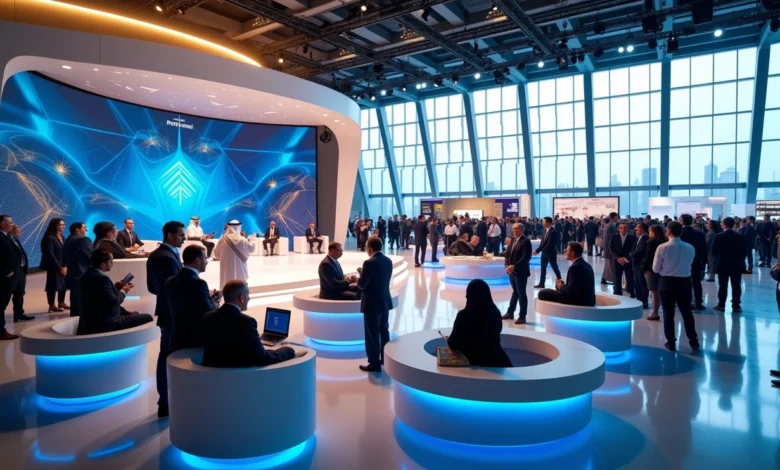
BRIDGE Summit 2025: Global Media Giants Unite in Abu Dhabi
The BRIDGE Summit 2025 will unite more than 100 global media pioneers, founders, policymakers, and investors to tackle the industry’s biggest challenges. This landmark event will take place from December 8-10 at the Abu Dhabi National Exhibition Center (ADNEC). The organizers expect over 60,000 participants, 400 speakers, and 300 exhibitors to attend.
The summit comes at a pivotal moment in media evolution. Streaming services now dominate traditional broadcast channels. Social media platforms have surpassed newsrooms in reach. AI continues to alter the map of truth creation and consumption. The BRIDGE Summit 2025 Abu Dhabi will dive deep into these changes through seven specialized tracks: Media, Content Creators, Music, Gaming, Marketing, Tech, AI, and Picture.
The Media Track stands out with more than 100 global editors who will lead 50+ sessions. They will address a critical challenge facing the global information order – the decline in audience trust. The UAE National Media Office’s BRIDGE Summit 2025 goes beyond a typical conference. It serves as a global platform where creators, investors, and policymakers can collaborate to create value and new chances. This becomes crucial as questions of ownership, influence, and accountability shape our information ecosystem.
Media Track Brings Global Voices to Abu Dhabi
“Through Bridge Summit, we aim to create a global space where media and content transcend traditional boundaries to encompass all sectors defining today’s global content economy.” — Dr Jamal Al Kaabi, Vice President of Bridge Summit
The Media Track represents one of seven strategic content pillars at the BRIDGE Summit 2025 in Abu Dhabi. This specialized track will bring together more than 100 global editors, founders, policymakers, and investors across 50+ sessions at the Abu Dhabi National Exhibition Center (ADNEC) from December 8-10.
What is the Media Track at BRIDGE Summit 2025?
The Media Track looks at the rise of journalism, news broadcasting, and the economics of digital storytelling. Modern media needs to rebuild trust through transparency, audience involvement, and algorithmic discovery in the information age. The track brings together stakeholders from different sectors to share knowledge and build partnerships that create a more resilient global media ecosystem.
Sessions at the Media Track cover topics that shape modern media significantly. Panels like “Money Talks: Who’s Funding the News You Read?”, “Media’s New Centers of Gravity,” and “Who Pays When Journalism Goes Broke?” look at how funding and ownership models influence editorial independence. Discussions such as “The Threshold of Truth” and “Who Can You Trust?” focus on credibility standards as AI and algorithmic storytelling advance.
Who are the key speakers and participants?
The track features an impressive lineup of media pioneers, cultural leaders, and policy thinkers who represent institutions redefining global information systems. Notable speakers include:
- Gary Vaynerchuk, Chairman of VaynerX
- Moira Forbes, Executive Vice President of Forbes
- Jessica Sibley, CEO of TIME
- Joanna Coles, Chief Creative and Content Officer at The Daily Beast
- Justin Smith, Co-Founder and CEO of Semafor
- Nancy Gibbs, Director of Harvard’s Shorenstein Center and former Editor-in-Chief of TIME
Regional voices add depth to the conversation, including HRH Princess Lamia Bint Majid Al Saud from Saudi Arabia, Uche Pedro of Nigeria’s BellaNaija, Dr. Julie Gichuru from Kenya’s Africa Leadership and Dialog Institute, and Shekhar Gupta of India’s ThePrint.
How does the Media Track reflect global media challenges?
Traditional media boundaries have shifted dramatically. Streaming now dominates broadcast, social platforms have overtaken newsrooms, and AI changes how we create, verify, and share truth. Information has become a geopolitical tool, and sessions like “How Media Shapes the Course of Modern Conflict and Leaks” and “Whistleblowers and the New Information Battlefield” examine journalism’s relationship with security and global stability.
The BRIDGE Roadshow series of roundtables in New York, London, Shanghai, and Osaka throughout 2025 strengthens this global perspective. These diverse conversations help the Media Track fulfill the summit’s core mission: connecting global stakeholders to enhance the credibility, sustainability, and inclusivity of information systems worldwide.
AI and Algorithms Reshape Media Credibility
“Meta’s role is hands-on. The plan includes immersive learning experiences using AR and VR, plus sessions on behavioral data and interaction design.” — Meta (official statement), Meta Platforms, Inc.
AI’s expanding role in media ecosystems will take center stage at BRIDGE Summit 2025. This technology has revolutionized how we establish credibility in today’s information space.
How is artificial intelligence changing storytelling?
AI has revolutionized journalists’ information processing capabilities. They can now analyze data volumes that are so big at speeds nowhere near possible with traditional methods. The technology handles time-consuming work like transcription and first drafts. This allows journalists to dedicate their time to deeper investigations. AI can also detect emotional patterns in content and analyze visual valence in videos. These capabilities help create emotional arcs that could boost audience engagement. The technology brings many benefits, but it also raises important questions about editorial control. BRIDGE Summit 2025 Abu Dhabi will get into these concerns.
What are the risks of synthetic content and deepfakes?
Deepfakes have evolved significantly since their 2017 debut. These sophisticated tools can now convincingly copy people’s voices and appearances. Recent data shows 46% of fraud experts have encountered synthetic identity fraud, while 37% have dealt with voice deepfakes. These technologies make it harder to separate truth from fiction. Researchers call this the “liar’s dividend” – a situation where real recordings get dismissed as likely fakes. The UAE National Media Office’s BRIDGE Summit 2025 will focus on creating protective measures against these threats.
Can algorithmic distribution be made transparent?
Algorithms work like “black boxes” with hidden decision-making processes. Studies show that when people think news recommender systems are being used more, they trust media outlets less. Making algorithms transparent by revealing human input, data sources, and modeling methods has become crucial. This transparency could help rebuild public trust in digital information systems.
Funding Models Challenge Editorial Independence
Money pressures are altering the map of journalism. The BRIDGE Summit 2025 will look at how funding shapes the stories we read and watch.
Who funds the news in 2025?
The news industry looks very different today. Commercial newspaper revenue hit its peak at AED 326.80 billion in 2000, but the landscape has changed dramatically since then. Financial institutions now control most media outlets – they make up 56% of legal owners, or 73 out of 130 identified owners. Philanthropic support has grown into a big deal, and more than half of funders have increased their journalism grants in the last five years. While nonprofit journalism attracts 64% of philanthropic donors, 38% also support for-profit news organizations.
What are the new ownership structures in journalism?
Traditional publishing companies no longer dominate media ownership. Most legal media owners (49.6%) now operate from outside their target markets. Research shows that ownership type shapes content directly. Corporate-owned media outlets talk about their ownership interests more often than others, showing what researchers call “promotional economic instrumentalism”. Public media consistently shows stronger public service commitment compared to private and corporate outlets.
How are philanthropy and venture capital influencing content?
News organizations face fresh challenges to their editorial independence as funding sources multiply. While 92% of nonprofit news outlets say funders never preview content, some risks remain – 57% of funders support journalism in areas where they also work on policy. The good news is that transparency has improved. Today, 70% of nonprofit newsrooms have written policies about disclosing their funders, up from 40% eight years ago. The Bridge Summit 2025 Abu Dhabi will take a closer look at creating universal guidelines. These guidelines are crucial to maintain public trust as editorial boundaries become less clear.
Gen Z and Subcultures Redefine Media Engagement
Image Source: European Association for International Education
Youth audiences play a key role at the BRIDGE Summit 2025. Their changing consumption patterns are reshaping global media economics.
Why is Gen Z disengaging from traditional media?
Gen Z tops all generations in daily media consumption with 6.6 hours per day. Their engagement looks nothing like older age groups. All but one of these young people never watch linear television. Gen Z spends less than an hour daily with traditional TV. These digital natives prefer their smartphones, dedicating 31.6% of their media time to mobile devices. Unlike older generations who love TV, Gen Z gravitates toward interactive experiences. About 43% of them take part in polls, quizzes, and Q&A sessions.
How are memes and short-form content becoming business models?
Memes have grown from internet jokes into powerful marketing tools. Meme-based content gets more and thus encourages more engagement – 60% higher than traditional branded content among Gen Z consumers. Meme marketing campaigns improve brand recall and engagement by 25-30% compared to standard advertisements. To name just one example, see Gucci’s success with their #TFWGucci campaign that earned 2 million likes and 21,000 comments. Short-form video has emerged as the marketing format with highest ROI, making platforms adapt quickly.
What does authenticity mean in the age of swipes?
Gen Z values real connections in digital spaces above everything else. Vice Media research shows these young people prioritize authenticity and trust. They often turn to their communities before they interact with external content. The UAE National Media Office’s BRIDGE Summit 2025 will get into how authenticity shows up externally—reflecting what audiences expect rather than internal values. Media companies need experts with real knowledge in their fields. Just hiring young presenters won’t appeal to youth demographics anymore.
The BRIDGE Summit 2025 marks a defining moment for the global media industry. More than 100 media pioneers, founders, policymakers, and investors will join forces at a crucial time. Streaming has overtaken traditional broadcast, social platforms have surpassed newsrooms, and AI has altered the map of truth creation and consumption.
The Media Track tackles core questions about trust, ownership, and accountability in our information ecosystem. Sessions about funding models reveal the delicate balance between money flows and editorial independence. This becomes even more relevant as financial actors and philanthropic supporters play bigger roles in media ownership.
Technology emerges as a key theme at the summit. AI tools now handle data analysis and content creation, but questions about transparency remain crucial. We need more openness in algorithmic distribution systems to restore audience’s trust.
The summit acknowledges Gen Z’s role in changing how people consume media. These young audiences prefer authentic, interactive experiences on smartphones instead of traditional TV. Media companies must adapt their business models to this reality. Short-form videos and meme-based content create much higher engagement rates. Authenticity has become the key to connecting with younger audiences.
The UAE National Media Office has made BRIDGE Summit 2025 more than just a conference. It serves as a global platform that brings together stakeholders of all types to boost credibility, sustainability, and inclusivity of information systems worldwide. Despite challenges in the media world, this unmatched gathering offers hope. The collective wisdom might create paths toward a stronger information ecosystem that benefits creators, investors, policymakers, and audiences alike.





